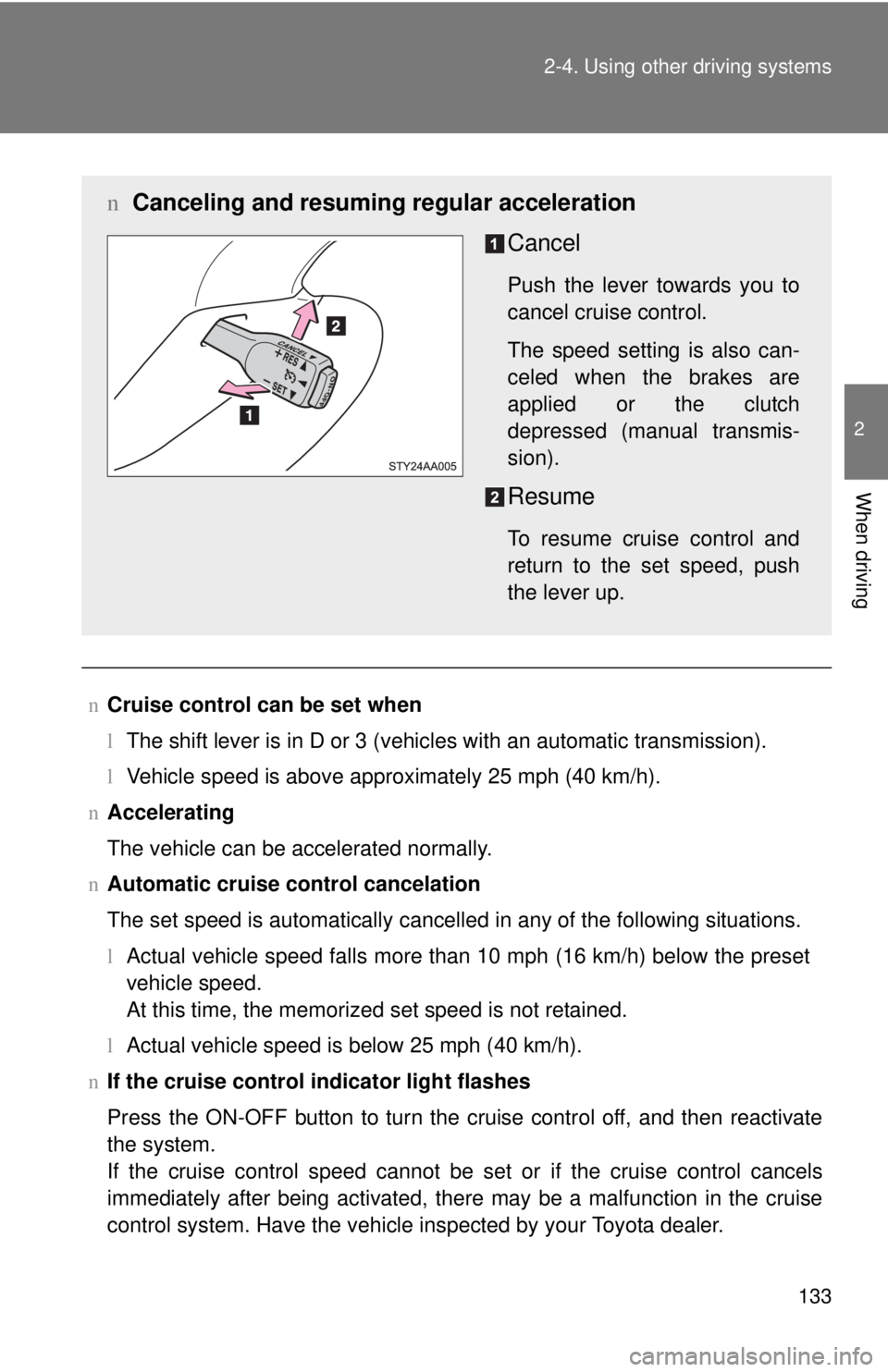Page 123 of 384
108
2-1. Driving procedures
Engine (ignition) switch
nEngine switch
LOCK
The steering wheel is locked
and the key can be removed.
ACC
Some electrical components
such as the audio system can
be used.
ON
All electrical components can
be used.
START
For starting the engine.
nStarting the engine
Automatic transmission
Check that the parking brake is set.
Check that the shift lever is set in P.
Sit in the driver’s seat and firmly depress the brake pedal.
Turn the engine switch to the START position and start the
engine.
The engine will crank until it starts or for up to 20 seconds, which-
ever is less.
Continue depressing the brake pedal until the engine is com-
pletely started.
Page 124 of 384
109
2-1. Driving procedures
2
When driving
Manual transmission
Check that the parking brake is set.
Check that the shift lever is set in N. Firmly depress the brake pedal and clutch pedal.
Turn the engine switch to the START position and start the engine.
The engine will crank until it starts or for up to 20 seconds, which-
ever is less.
Continue depressing the brake pedal and clutch pedal until the
engine is completely started.
Page 125 of 384
110 2-1. Driving procedures
nTurning the key from ACC to LOCK
n Steering lock release
n If the engine does not start (vehic les with engine immobilizer system)
The engine immobilizer system may not have been deactivated. ( →P. 59)
n Key reminder function
A buzzer sounds if the driver’s door is opened, while the engine switch is in
the ACC or LOCK position to remind you to remove the key.
CAUTION
nWhen starting the engine
Always start the engine while sitting in the driver's seat. Do not depress the
accelerator while starting the engine under any circumstances.
Doing so may cause an accident resulting in death or serious injury.
Shift the shift lever to P (auto-
matic transmission) or N (man-
ual transmission). ( →P. 112, 114)
Push in the key and turn to the
LOCK position.
When starting the engine, the engine
switch may seem stuck in the LOCK posi-
tion. To free it, turn the key while turning
the steering wheel slightly in either direc-
tion.
Page 127 of 384
112
2-1. Driving procedures
Automatic Transmission (if equipped)
Select a shift position appropriate for the driving conditions.
nShifting the shift lever
While the engine switch is on, depress the brake pedal and
move the shift lever.
Page 129 of 384
114
2-1. Driving procedures
Manual Transmission (if equipped)
nMaximum allowable speeds
Observe the following maximum allowable speeds in each gear when maxi-
mum acceleration is necessary.
mph (km/h)
nShifting the shift lever
Fully depress the clutch pedal before operating the shift lever, and
then release it slowly.
Shift positionMaximum speed
1 31 (51)
2 59 (95)
3 86 (139)
Page 140 of 384
125
2-2. Instrument cluster
2
When driving
n
Indicators
The indicators inform the driver of the operating state of the
vehicle’s various systems.
Turn signal indicator
(→P. 115)Low engine coolant
temperature indicator
Headlight high beam
indicator ( →P. 127)Indicates the engine
coolant temperature is
cool.
(except
Canada)
Headlight indicator
( →P. 127)
(if equipped)
Cruise control indicator
( →P. 132)
(Canada)
Tail light indicator
(→P. 127)AIR BAG ON indicator
( →P. 78)
(if equipped)
Front fog light indicator
(→P. 129)AIR BAG OFF indicator
( →P. 78)
(Automatic transmission vehicles
with tachometer)
Shift position and shift range indica-
tors ( →P. 112)
(Automatic transmission vehicles
without tachometer)
Shift position and shift range indica-
tors (→P. 112)
Page 148 of 384

133
2-4. Using other
driving systems
2
When driving
nCruise control can be set when
lThe shift lever is in D or 3 (vehicles with an automatic transmission).
l Vehicle speed is above approximately 25 mph (40 km/h).
n Accelerating
The vehicle can be accelerated normally.
n Automatic cruise control cancelation
The set speed is automatically cancelled in any of the following situations.
lActual vehicle speed falls more than 10 mph (16 km/h) below the preset
vehicle speed.
At this time, the memorized set speed is not retained.
l Actual vehicle speed is below 25 mph (40 km/h).
n If the cruise control indicator light flashes
Press the ON-OFF button to turn the cruise control off, and then reactivate
the system.
If the cruise control speed cannot be set or if the cruise control cancels
immediately after being activated, there may be a malfunction in the cruise
control system. Have the vehicle inspected by your Toyota dealer.
n Canceling and resuming regular acceleration
Cancel
Push the lever towards you to
cancel cruise control.
The speed setting is also can-
celed when the brakes are
applied or the clutch
depressed (manual transmis-
sion).
Resume
To resume cruise control and
return to the set speed, push
the lever up.
Page 149 of 384
134 2-4. Using other driving systems
CAUTION
nTo avoid operating the cruise control by mistake
Keep the ON-OFF button off when not in use.
n Situations unsuitable for cruise control
Do not use cruise control in any of the following situations.
Doing so may result in control of the vehicle being lost and could cause seri-
ous or fatal accident.
lIn heavy traffic
l On roads with sharp bends
l On winding roads
l On slippery roads, such as those covered with rain, ice or snow
l On steep hills
n While driving with the cruise control on
Vehicles with a manual transmission, do not shift to neutral without depress-
ing the clutch pedal, as this may cause engine racing or overrevving.